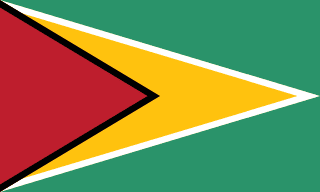
Today I arrived in Guyana. Somewhere between the dense jungle canopy and the sunlit surface of the Demerara River, the country unfolded like a whispered story. Guyana is not the South America most people imagine—there are no tango plazas or Andean peaks here. Instead, there are emerald forests, colonial echoes, and the murmur of creole markets, all wrapped in a Caribbean rhythm. This is a land where water sings and trees hold memory.
📌 Table of Contents
- Location and Flag
- Guyana’s Historical Journey
- Landmarks and Natural Wonders
- The Spirit of Today’s Guyana
- A Day in the Life of a Local
- Glossary of Local Terms
📍 Location and Flag
Guyana lies on the northern coast of South America, bordered by Venezuela, Brazil, Suriname, and the Atlantic Ocean. It is the only English-speaking country on the continent, often culturally linked more to the Caribbean than to its southern neighbors.

The flag, often called "The Golden Arrowhead," features red for zeal, gold for mineral wealth, green for forests, black for endurance, and white for rivers. It’s a vibrant symbol for a country defined by natural abundance and multicultural strength.
🏛️ Guyana’s Historical Journey
Long before colonial lines were drawn, the lands of Guyana were home to the Arawak and Carib peoples, whose myths, languages, and traditions still whisper through the forest paths. With European contact came layers of disruption. First the Dutch arrived in the 17th century, then the British, who made Guyana a colony in the early 19th century.
The legacy of colonization is complex. Plantations brought enslaved Africans, and after emancipation, indentured laborers from India, China, and Portugal. Guyana became a multicultural mosaic—each community enduring hardship yet contributing to a shared identity.
Independence came in 1966, followed by years of political struggle and economic challenge. But resilience is woven deep into the Guyanese soul. The past, though heavy, has not hardened them—it has taught them to bend like cane in the wind, never breaking.
🌄 Landmarks and Natural Wonders
- Kaieteur Falls –Kaieteur Falls is celebrated as one of the world’s most powerful single‑drop
waterfalls by water volume, while the record for the tallest single‑drop
belongs to Angel Falls in Venezuela (807 m). - Georgetown – The capital city reflects British colonial architecture, vibrant markets, and the imposing St. George’s Cathedral, one of the tallest wooden churches in the world. Its streets carry both the past and the pulse of today.
- Iwokrama Rainforest – A protected area that spans nearly one million acres, this reserve shelters jaguars, giant river otters, and more than 500 species of birds. The Canopy Walkway offers a view into the treetops—and the untouched.
- Shell Beach – Stretching over 90 miles along the Atlantic, Shell Beach is a nesting site for four species of sea turtles. It's also a remote haven where nature holds dominion.
📊 The Spirit of Today’s Guyana
Guyana today stands at a crossroads. With major offshore oil discoveries in recent years, the nation is transitioning rapidly. New investments, infrastructure, and political stakes emerge alongside age-old concerns about equity, environment, and identity.
Yet beyond economics, it is the people who define this moment. Guyana is a cultural kaleidoscope—Afro-Guyanese, Indo-Guyanese, Indigenous, Chinese, and Portuguese roots blending into a singular voice. English is spoken, but so are Creole, Hindi, and Indigenous tongues.
Music drifts from radios: chutney, reggae, soca, gospel. Food steams on every corner—pepperpot stew, dhal and rice, cassava bread. Cricket remains a national passion, but so does storytelling, and community gatherings under the shade of mango trees.
🧍 A Day in the Life of a Local
Morning light breaks over wooden homes on stilts. In villages and towns, roosters crow and fires are lit beneath pots of porridge or fish stew. Children in bright uniforms walk to school, past roadside stands selling pineapples, plantains, and coconut water.
The midday sun is fierce. Workers rest under zinc roofs, fanning themselves while sipping mauby or ginger beer. The rhythm of the day is not hurried but steady—life here listens to the land. In the evening, radios echo cricket commentary. Laughter rises from front steps where neighbors share news. As night falls, the jungle hums, and stars crowd the sky. It is not silence, but serenity.
📚 Glossary of Local Terms
| Term | Definition |
|---|---|
| Kaieteur | Massive waterfall in central Guyana, symbolic of natural grandeur |
| Pepperpot | Traditional Guyanese stew made with meat, spices, and cassareep (cassava extract) |
| Roti | Indian flatbread commonly eaten with curry dishes |
| Creole | A Guyanese-English dialect widely spoken in informal settings |
| Mauby | Local drink made from tree bark, spices, and sugar |
👣 Guyana is not a place that shouts. It murmurs. It invites. It reveals. From the depths of its rainforests to the heights of Kaieteur, it offers stories that are not written but lived—leaf by leaf, river by river. In its quiet strength and cultural complexity, Guyana remains one of South America's most poetic and powerful secrets.
'책 위의 세계걷기 195 > Walking the World Across Pages : 195' 카테고리의 다른 글
| North America – Guatemala, Tracing the Breath of the Maya (1) | 2025.04.22 |
|---|---|
| Africa – Ghana, Walking Through Gold and Cocoa (0) | 2025.04.22 |
| 🌍 Ep.1 Europe – Greece: Stepping into the Roots of Civilization (0) | 2025.04.20 |
| Nepal — where life blossoms beneath the Himalayas (0) | 2025.04.19 |



